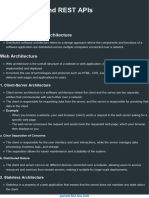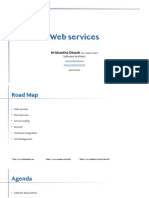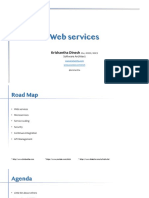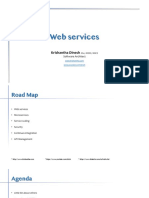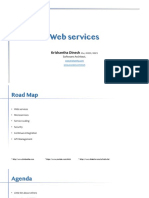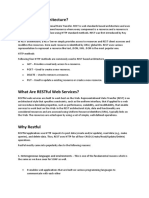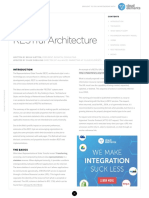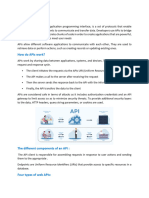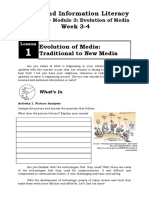MERN Stack Unit 4
Uploaded by
chanda anushaMERN Stack Unit 4
Uploaded by
chanda anushalOMoARcPSD|5982446
8. Monitor and Scale: Monitor your deployed application's performance, resource usage,
and errors using the cloud platform's monitoring and logging tools. Based on the
traffic and demand, scale your application horizontally (adding more instances) or
vertically (increasing resources) to ensure optimal performance.
9. Security and Access Control: Implement security measures such as access control,
firewalls, encryption, and identity and access management (IAM) to protect your
application and data on the cloud platform.
10. Continuous Deployment and DevOps: Consider setting up continuous integration and
deployment (CI/CD) pipelines to automate the process of building, testing, and
deploying your application updates. Use DevOps practices to streamline development,
deployment, and operations.
It's important to refer to the documentation and resources provided by the specific
cloud platform you choose, as the deployment process may vary depending on the
platform and services you utilize.
UNIT-IV
RESTful Web Services:
RESTful web services, or simply REST (Representational State Transfer), are a
popular architectural style used for designing networked applications. RESTful
services enable communication between systems over the internet, allowing clients to
access and manipulate resources on a server using a set of predefined operations.
Here are some key concepts and principles associated with RESTful web services:
1. Resources: In REST, everything is treated as a resource, such as an object, a
document, or a data entity. Resources are identified by unique URIs (Uniform
Resource Identifiers) and can be accessed via HTTP methods.
2. HTTP Methods: RESTful services utilize the standard HTTP methods for performing
different operations on resources. The commonly used methods are:
GET: Retrieves the representation of a resource.
Downloaded by Prudhvi Dil (prudhvitejadil22@gmail.com)
lOMoARcPSD|5982446
POST: Creates a new resource.
PUT: Updates an existing resource.
DELETE: Deletes a resource.
3. Uniform Interface: RESTful services follow a uniform interface constraint, which
means they have a consistent set of principles and conventions for interacting with
resources. This includes the use of HTTP methods, URIs, and standard response
codes.
4. Stateless: REST is stateless, which means that each request from a client to a server
must contain all the necessary information to understand and process the request. The
server does not maintain any client state between requests.
5. Representation: Resources are represented in a standardized format, such as JSON
(JavaScript Object Notation) or XML (eXtensible Markup Language). Clients and
servers can exchange representations of resources to communicate and perform
operations.
6. Hypermedia as the Engine of Application State (HATEOAS): HATEOAS is a
principle of REST that suggests including hyperlinks in the response to guide clients
on how to interact with the available resources. These hyperlinks provide a self-
descriptive API that allows clients to navigate the application state.
By following these principles, RESTful web services provide a scalable and flexible
architecture for building distributed systems. They are widely used for developing
web APIs, enabling different client applications (web, mobile, IoT, etc.) to interact
with server resources over the internet in a standardized manner.
RESTful Web Services Using the Uniform Interface:
RESTful web services adhere to the principles of the uniform interface, which
provides a consistent and standardized way for clients to interact with server
resources. The uniform interface in REST is based on the following key elements:
Downloaded by Prudhvi Dil (prudhvitejadil22@gmail.com)
lOMoARcPSD|5982446
1. Resource Identification: Each resource in a RESTful service is uniquely identified by
a URI (Uniform Resource Identifier). URIs are used by clients to access and
manipulate the resources. For example, a URI like /users/123 can represent a specific
user resource with the ID 123.
2. HTTP Methods: RESTful services utilize the standard HTTP methods to perform
different operations on resources. The commonly used methods are:
GET: Retrieves the representation of a resource. Clients use this method to
retrieve data from the server.
POST: Creates a new resource. Clients use this method to submit data to the
server for creation.
PUT: Updates an existing resource. Clients use this method to send the updated
representation of a resource to the server.
DELETE: Deletes a resource. Clients use this method to request the removal of
a resource from the server.
By using these HTTP methods, clients can perform specific actions on resources using
a uniform interface.
3. Representation: Resources in RESTful services are represented in a standardized
format, such as JSON or XML. Clients and servers exchange representations of
resources as part of their communication. The representation format can be negotiated
between the client and server using the Accept and Content-Type headers in the
HTTP request and response.
4. Self-Descriptive Messages: RESTful services rely on self-descriptive messages, which
means that each message contains enough information for the recipient (client or
server) to understand and process it. The messages typically include metadata, such as
HTTP headers, that provide additional context and instructions.
5. Hypermedia Controls (HATEOAS): The principle of Hypermedia as the Engine of
Application State (HATEOAS) suggests including hyperlinks in the response to guide
clients on how to interact with the available resources. These hyperlinks are embedded
within the response and provide navigation links to related resources. Clients can
follow these links to discover and access other resources, allowing for a self-
descriptive API.
Downloaded by Prudhvi Dil (prudhvitejadil22@gmail.com)
lOMoARcPSD|5982446
By following the principles of the uniform interface, RESTful web services provide a
standardized and interoperable approach for clients to interact with server resources.
The uniformity of the interface simplifies client implementation and enables loose
coupling between the client and server, promoting scalability and flexibility in
distributed systems.
Designing URIs:
When designing URLs for RESTful web services, it's important to follow best
practices and adhere to the principles of REST. Here are some guidelines to consider:
1. Use Nouns to Represent Resources: URLs should be designed to represent resources
in a RESTful manner. Use nouns to identify the resources rather than verbs. For
example, use /users to represent a collection of users or /users/{id} to represent a
specific user.
2. Use Plural Nouns for Collections: When representing a collection of resources, use
plural nouns in the URL. For example, /users instead of /user for a collection of
users.
3. Maintain Consistency: Ensure consistency in your URL design throughout the API.
Use a consistent naming convention for resources and avoid unnecessary variations.
For example, if you use /users to represent users, be consistent and avoid using
/customers for a similar resource.
4. Avoid Nested URLs for Simplicity: Keep URLs simple and avoid excessive nesting or
deep hierarchies. Nested URLs can become complex and difficult to manage. If
necessary, limit the depth of nesting to a reasonable level.
5. Use Hyphens or Underscores for Readability: When separating words in a URL, you
can use hyphens (-) or underscores (_) for improved readability. For example, /user-
profiles or /user_profiles.
6. Include Resource Identifiers: Include resource identifiers in the URL to represent
individual resources. For example, /users/{id} to represent a specific user by their ID.
Downloaded by Prudhvi Dil (prudhvitejadil22@gmail.com)
lOMoARcPSD|5982446
7. Use Query Parameters for Filtering, Sorting, and Pagination: Use query parameters to
handle filtering, sorting, and pagination requirements. For example, /users?
role=admin&sort=name to retrieve users filtered by role and sorted by name.
8. Avoid Including Actions in URLs: Instead of including actions (verbs) in URLs, use
appropriate HTTP methods to perform actions on resources. For example, use POST
to create a new resource, PUT to update a resource, and DELETE to delete a
resource.
9. Versioning: If you anticipate making changes to your API in the future, consider
incorporating versioning into the URL structure. For example, /v1/users to represent
the first version of the users resource.
10. Follow Security Considerations: Ensure URLs don't expose sensitive information and
implement proper security measures, such as authentication and authorization, to
protect your API.
Remember, designing URLs for RESTful web services should focus on creating a
clear, intuitive, and consistent structure that represents resources and promotes ease of
use for clients interacting with your API.
Weblinking:
Web linking, also known as Hypermedia as the Engine of Application State
(HATEOAS), is an important concept in RESTful web services. It involves including
hyperlinks within API responses to guide clients on how to interact with available
resources. The use of web links enables clients to discover and navigate the API
dynamically.
Here are some key points to understand about web linking in RESTful web services:
1. Hypermedia Controls: In RESTful services, API responses include hypermedia
controls or links. These links provide navigational information and options for clients
to perform actions on related resources. The links are typically embedded within the
response body or included in specific response headers.
Downloaded by Prudhvi Dil (prudhvitejadil22@gmail.com)
lOMoARcPSD|5982446
2. Resource Relationships: Web links help define relationships between resources. They
allow clients to traverse from one resource to another by following the provided links.
For example, a user resource may contain links to related resources such as their posts
or comments.
3. Self-Descriptive API: The inclusion of hyperlinks makes the API self-descriptive.
Clients can understand the available actions and resources by following the links
provided in the responses. This eliminates the need for clients to have prior knowledge
of the API structure and enables them to navigate and interact with resources
dynamically.
4. Discoverability: Web links facilitate the discoverability of resources within the API.
Clients can start with a known entry point, such as the API root URL, and explore
available resources by following the links provided in the responses. This allows for a
more flexible and adaptable client-server interaction.
5. Reduced Coupling: By relying on hypermedia controls, clients and servers achieve
loose coupling. Clients are not tightly bound to specific URI patterns or API versions
but instead rely on the provided links to navigate the API. This promotes decoupling
and allows for easier evolution and versioning of the API.
6. Link Relation Types: Links in RESTful services often include relation types that
indicate the semantics of the link. Common relation types include "self" (link to the
current resource), "next" (link to the next page in a paginated collection), "prev" (link
to the previous page), and custom relation types specific to the API's domain.
7. Link Format: Links typically include the URI of the related resource along with other
optional information such as the link's relation type and human-readable title. The
format commonly used to represent links in JSON is:
“rel”: “relation-type” ,
“href” : “https://example.com/resourse “,
“title” : “Link-Title”
Downloaded by Prudhvi Dil (prudhvitejadil22@gmail.com)
lOMoARcPSD|5982446
By incorporating web linking into RESTful web services, APIs become more self-
descriptive, discoverable, and adaptable. Clients can navigate the API dynamically by
following the provided links, reducing coupling and promoting a more flexible client-
server interaction.
Conditional Requests :
Conditional requests are a feature in RESTful web services that allow clients to
perform requests with certain conditions, enabling more efficient and optimized
interactions with the server. Conditional requests are based on HTTP headers and
status codes to indicate the conditions and responses to those conditions. Here are the
key components of conditional requests in RESTful web services:
1. ETag (Entity Tag): An ETag is an identifier associated with a specific version of a
resource. The server generates an ETag and includes it in the response headers when a
resource is requested. The ETag can be viewed as a unique fingerprint of the
resource's current state.
1. If-Match Header: Clients can include the ‘If-Match’header in their requests to specify
that the request should only be processed if the provided ETag matches the current
ETag of the resource on the server. If the ETags match, the request is processed;
otherwise, a ‘412 Precondition Failed’ status code is returned.
2. If-None-Match Header: The ‘If-None-Match’header allows clients to request a
resource only if it has been modified since a specified ETag value. If the current ETag
matches the provided ETag, the server returns a ‘304 Not Modified’ status code
without sending the resource again. This saves bandwidth and reduces unnecessary
data transfers.
3. Last-Modified Header: The ‘Last-Modified’ header is a timestamp indicating the last
modification time of a resource. It is returned by the server in the response headers.
Clients can include the ‘If-Modified-Since’ header in subsequent requests to check if
the resource has been modified since the specified timestamp. If the resource has not
been modified, the server returns a ‘304 Not Modified’ status code.
Downloaded by Prudhvi Dil (prudhvitejadil22@gmail.com)
lOMoARcPSD|5982446
4. If-Modified-Since Header: Clients can include the ‘If-Modified-Since’ header in a
request with a timestamp to indicate that the request should only be processed if the
resource has been modified since the provided timestamp. If the resource has not been
modified, the server returns a ‘304 Not Modified’ status code.
By utilizing these conditional request mechanisms, clients can minimize unnecessary
data transfer and reduce server load by only requesting and retrieving resources that
have been modified since their last retrieval. This helps improve performance and
efficiency in RESTful web service interactions.
ReactJS:
ReactJS, often referred to as React, is an open-source JavaScript library for building
user interfaces (UIs) and developing web applications. It was created by Facebook and
released in 2013. React allows developers to create reusable UI components and
efficiently update and render them when the underlying data changes.
Key features of React include:
1. Component-Based Architecture: React uses a component-based approach, where UIs
are built by combining reusable components. Each component manages its own state
and can be composed together to create complex user interfaces.
2. Virtual DOM: React introduces a virtual representation of the actual browser
Document Object Model (DOM) called the Virtual DOM. React's Virtual DOM
allows it to efficiently update and render only the necessary components when the
application state changes, leading to improved performance.
3. JSX: React utilizes JSX (JavaScript XML), which is an extension to JavaScript
syntax. It allows developers to write HTML-like code within JavaScript, making it
easier to define the structure and appearance of components.
4. Unidirectional Data Flow: React follows a unidirectional data flow, also known as
one-way data binding. Data flows from parent components to child components,
ensuring a predictable state management and making it easier to debug and understand
the application's behavior.
Downloaded by Prudhvi Dil (prudhvitejadil22@gmail.com)
lOMoARcPSD|5982446
5. React Native: React Native, a framework built on top of React, enables the
development of native mobile applications for iOS and Android platforms using
JavaScript. With React Native, developers can write a single codebase that runs on
multiple platforms, providing a significant advantage for cross-platform app
development.
React has gained popularity due to its simplicity, performance optimizations, and a
large ecosystem of community-driven libraries and tools. It is widely used by both
small and large organizations to build interactive and dynamic web applications.
Additionally, React's component-based architecture and declarative nature make it
easier to test, maintain, and collaborate on projects.
Obstacles and Roadblocks n React JS:
While React JS is a popular and powerful framework for building web applications,
developers may encounter certain obstacles or roadblocks during their journey. Here
are a few common challenges and ways to overcome them:
1. Learning Curve: React has a learning curve, especially for developers who are new to
JavaScript frameworks or have a background in different frameworks. It may take
time to grasp concepts like JSX, component lifecycle, state management, and React's
overall philosophy. To overcome this, it's recommended to follow official
documentation, tutorials, and online courses that provide step-by-step guidance.
Practice building small projects and gradually increase the complexity as you gain
more familiarity with React.
2. State Management: As applications grow in size and complexity, managing
application state becomes more challenging. React itself doesn't provide a built-in
solution for state management, so developers often rely on external libraries such as
Redux, MobX, or React Context API. These libraries help manage state in a more
structured and scalable manner. Understanding the principles and patterns of state
management libraries can help overcome this roadblock.
Downloaded by Prudhvi Dil (prudhvitejadil22@gmail.com)
lOMoARcPSD|5982446
3. Performance Optimization: While React's Virtual DOM efficiently updates and
renders components, it's still possible to encounter performance issues, especially
when dealing with large datasets or complex UIs. Common performance optimization
techniques in React include implementing shouldComponentUpdate or React.memo to
prevent unnecessary re-renders, using keys properly when rendering lists, and
employing code-splitting and lazy loading to improve initial load times. Profiling tools
like React DevTools and browser developer tools can help identify performance
bottlenecks and optimize the application.
4. Integration with Legacy Code: Integrating React into an existing codebase or working
with legacy code can be challenging. It's essential to understand how React fits into
the existing architecture and decide whether to introduce React incrementally or
refactor the entire codebase. Consider using React's integration capabilities, such as
ReactDOM.render() to embed React components into existing pages, or using React in
combination with other frameworks or libraries as needed.
5. Testing: Writing comprehensive and reliable tests for React components and
application logic is crucial for maintaining code quality. However, testing React
components may require additional setup and understanding of testing libraries like
Jest, Enzyme, or React Testing Library. Investing time in learning testing best
practices, writing unit tests for components, and using tools to simulate user
interactions can help ensure the stability and maintainability of your React
applications.
Remember that overcoming obstacles in React is a natural part of the learning process.
Don't hesitate to seek help from the vibrant React community through forums,
discussion boards, or social media groups. Many developers have faced similar
challenges and can provide guidance and insights to help you overcome any
roadblocks you encounter.
React’s Future: React has established itself as one of the most popular
JavaScript libraries for building user interfaces, and its growth and adoption continue
to be strong. Here are a few aspects that indicate a promising future for React:
Downloaded by Prudhvi Dil (prudhvitejadil22@gmail.com)
lOMoARcPSD|5982446
1. Continued Growth: React's popularity and usage have been steadily increasing over
the years, and there is no sign of a decline. Its large community of developers and
extensive ecosystem of libraries, tools, and resources contribute to its continued
growth and support.
2. React Native and Mobile Development: React Native, the framework built on top of
React, has gained significant traction in the mobile app development space. It enables
developers to build native mobile apps for multiple platforms using React and
JavaScript. With the rise of mobile app development and the demand for cross-
platform solutions, React Native is likely to play a crucial role in the future of mobile
development.
3. React Server Components: React Server Components is an experimental feature
introduced by the React team. It aims to bring the benefits of React's component
model to the server-side rendering (SSR) process. This can potentially improve
performance and facilitate seamless code sharing between client and server. While
still in the early stages of development, React Server Components could shape the
future of server-side rendering in React applications.
4. React as a UI Framework: React's component-based architecture and its ability to
create reusable UI components make it a powerful tool for building user interfaces.
With the rise of component-based development and design systems, React is likely to
continue playing a prominent role in the development of UI frameworks and libraries.
5. React Concurrent Mode: React Concurrent Mode is an upcoming feature aimed at
improving the performance and responsiveness of React applications. It introduces
new patterns and APIs to handle asynchronous rendering, allowing components to
work on different priorities and enable more interactive user experiences. Once fully
released, Concurrent Mode has the potential to further enhance React's capabilities
and user experience.
It's worth noting that the web development landscape is constantly evolving, and new
frameworks and technologies emerge over time. However, React's strong community
support, continuous updates, and the backing of Facebook make it well-positioned for
a promising future in the web development space.
Downloaded by Prudhvi Dil (prudhvitejadil22@gmail.com)
lOMoARcPSD|5982446
It's always a good practice to stay updated with the latest releases and developments in
the React ecosystem to leverage the newest features and best practices as they become
available.
Keeping Up with the Changes in ReactJS :
Keeping up with the changes in ReactJS is important to stay updated with the latest
features, improvements, and best practices. Here are some tips to help you stay
informed:
1. Official Documentation: The ReactJS documentation is the primary and most reliable
source of information. It provides comprehensive guides, tutorials, API references,
and examples. Regularly visit the official React documentation website
(https://reactjs.org/) to explore the latest updates and new features.
2. React Blog: The React team maintains an official blog (https://reactjs.org/blog/) where
they share announcements, updates, and insights about React. Subscribe to the blog's
RSS feed or sign up for the React newsletter to receive notifications about new
releases and important updates.
3. GitHub Repository: React's GitHub repository (https://github.com/facebook/react) is
where the React source code resides. By monitoring the repository, you can keep track
of the latest commits, issues, and discussions. Additionally, you can star the repository
to receive notifications about new releases and updates.
4. Community Forums and Discussion Boards: Participate in React-related forums and
discussion boards to connect with the community, ask questions, and share
knowledge. The React subreddit (https://www.reddit.com/r/reactjs/) and the
Reactiflux Discord community (https://www.reactiflux.com/) are popular platforms
for discussions and Q&A.
5. React Conferences and Meetups: Attend React conferences and local meetups to learn
from industry experts, listen to talks, and engage in discussions about the latest trends
and updates in React. These events often provide valuable insights and networking
opportunities.
Downloaded by Prudhvi Dil (prudhvitejadil22@gmail.com)
lOMoARcPSD|5982446
6. Follow Influencers and Experts: Follow influential developers, React core team
members, and experts on social media platforms like Twitter and LinkedIn. They
often share their thoughts, insights, and updates about React, keeping you informed
about the latest happenings.
7. Newsletters and Podcasts: Subscribe to React-focused newsletters and podcasts that
provide regular updates and insights about React. Some popular newsletters include
"React Status" (https://react.statuscode.com/) and "React Digest"
(https://reactdigest.net/). Podcasts like "React Podcast" and "React Native Radio" also
cover React-related topics.
8. Open Source Projects and Libraries: Explore open source projects and libraries built
on top of React. These projects often reflect the latest trends and best practices in
React development. Following their repositories and documentation can help you stay
updated.
Remember that React is an evolving ecosystem, and it's important to allocate time
regularly to stay up to date. Experiment with new features, read release notes, and
consider updating your projects to newer versions of React when appropriate. By
actively engaging with the React community and staying informed about the latest
developments, you can ensure that your React skills and projects remain relevant and
up to date.
Working with the Files in ReactJS
Working with files in ReactJS typically involves handling file uploads, processing file
data, and interacting with the user's filesystem. Here's a high-level overview of file-
related operations in ReactJS:
1. File Input and Uploads: To enable file uploads, you can use the HTML ‘<input
type="file">’ element. In React, you can create a controlled component that handles
the file input value and listens to changes using the ‘onChange’ event. You can then
retrieve the selected file(s) from the input element and perform actions like displaying
Downloaded by Prudhvi Dil (prudhvitejadil22@gmail.com)
lOMoARcPSD|5982446
file information, validating file types/sizes, and initiating file uploads to a server or
cloud storage.
2. File Processing: Once a file is uploaded or selected by the user, you may need to
process its contents. Common scenarios include reading file data, parsing file formats
(e.g., CSV, JSON), or performing client-side transformations. The FileReader API or
third-party libraries like Papa Parse or XLSX can be used to read and process file data
in various formats.
3. File Downloads: React provides ways to initiate file downloads from the client-side.
You can create a link (‘<a>’) element with the desired file URL and set the
‘download’ attribute to specify the desired file name. Clicking on this link triggers the
download. Alternatively, you can use third-party libraries or APIs for more advanced
download functionality, such as generating files dynamically or downloading files
from external sources.
4. Drag and Drop: React allows you to implement drag-and-drop functionality to enable
users to drag files from their filesystem and drop them onto a designated area in the
application. By handling the ‘drag’ and ‘drop’ events, you can retrieve the dropped
files, validate them, and perform actions accordingly.
5. File Validation and Error Handling: When working with files, it's important to
validate user inputs and handle errors gracefully. You can check file types, sizes, and
other properties to ensure they meet your application's requirements. Display
appropriate error messages or feedback to the user if the file is invalid or if any errors
occur during file operations.
6. Third-Party Libraries: React has a vast ecosystem of third-party libraries that can
simplify file-related tasks. Libraries like react-dropzone, react-filepond, and react-
dropzone-uploader provide pre-built components and APIs for handling file uploads
and drag-and-drop functionality. Evaluate these libraries to see if they meet your
specific requirements and integrate them into your React application.
Remember to consider security aspects when dealing with file uploads and processing.
Implement server-side validation and sanitization to prevent malicious file uploads
and potential security vulnerabilities.
Downloaded by Prudhvi Dil (prudhvitejadil22@gmail.com)
lOMoARcPSD|5982446
Working with files in ReactJS often involves a combination of JavaScript, HTML, and
CSS, along with the React component lifecycle and state management. By
understanding these concepts and utilizing appropriate libraries and APIs, you can
effectively handle file-related operations in your React applications.
Pure React:
Pure React, also known as Vanilla React, refers to using React without any additional
libraries or frameworks. It means leveraging only the core capabilities and APIs
provided by React itself, without relying on external dependencies like state
management libraries or UI frameworks.
When working with pure React, you primarily use React's core concepts, including
components, JSX, state, and lifecycle methods. Here's an overview of how these key
aspects work in pure React:
1. Components: React is built around the concept of components, which are reusable,
self-contained pieces of UI. Components can be functional components (using
functions) or class components (using ES6 classes). Components encapsulate their
own logic and state and can be composed together to build complex UIs.
2. JSX: JSX is a syntax extension for JavaScript that allows you to write HTML-like
code within your JavaScript code. It is used to define the structure and appearance of
React components. JSX makes it easier to write and visualize the component
hierarchy.
3. State: React components can have state, which is an object that stores data that can
change over time. State allows you to manage dynamic data within a component and
triggers re-rendering when the state updates. In pure React, you typically use the
setState method to update the component's state and trigger a re-render.
4. Lifecycle Methods: React components have lifecycle methods that are called at
different stages of a component's life, such as mounting, updating, and unmounting.
These methods allow you to perform actions at specific points in the component's
lifecycle, like initializing state, making API calls, or cleaning up resources.
Downloaded by Prudhvi Dil (prudhvitejadil22@gmail.com)
lOMoARcPSD|5982446
By using these core features of React, you can build interactive user interfaces and
handle user interactions effectively. However, keep in mind that as your application
grows in complexity, you may need to consider additional libraries or patterns for
state management, routing, and other advanced functionalities. Redux, React Router,
and other libraries can be introduced as needed, based on your project requirements.
Using pure React can be beneficial in terms of simplicity, learning the core concepts
deeply, and having full control over your application. It also helps to have a better
understanding of how React works under the hood. However, it's important to strike a
balance between leveraging the power of React itself and utilizing third-party libraries
to enhance productivity and maintainability in larger projects
Pagesetup n ReactJS:
In ReactJS, setting up pages involves creating components that represent different
pages or views of your application. Here's a general approach to setting up pages in
ReactJS:
1. Create Page Components: Identify the different pages or views of your application and
create separate components for each page. These components will serve as the
containers for the content and functionality specific to each page. For example, you
might have components like HomePage, AboutPage, ContactPage, etc.
2. Define Routes: To handle navigation between pages, you need to set up routing in
your React application. React Router is a popular library for handling routing in
React. Install React Router using npm or yarn, and define routes in your application.
Routes specify the URL paths and the corresponding page components to render. For
example, you can define a route for the home page ("/") to render the HomePage
component.
3. Render Pages: In your main application component, typically named App, import the
necessary page components and set up the routing configuration provided by React
Router. Inside the component, use the Router and Route components from React
Downloaded by Prudhvi Dil (prudhvitejadil22@gmail.com)
lOMoARcPSD|5982446
Router to map the defined routes to their respective page components. This ensures
that the correct page component is rendered based on the current URL.
4. Linking and Navigation: Use the Link component from React Router to create links
between different pages within your application. The Link component generates
anchor tags with proper URL routing, allowing users to navigate between pages
without reloading the entire application. For example, you can use the Link
component to create a navigation bar with links to different pages.
5. Page Content and Functionality: Each page component should contain the specific
content and functionality relevant to that page. Customize the content, layout, and
behavior of each page according to its requirements. You can utilize other React
components, state management techniques, and API integrations as needed for each
page.
By following this approach, you can set up pages in your ReactJS application, enable
routing between them, and define the content and functionality specific to each page.
React Router provides a flexible and powerful way to handle page navigation and
URL routing in React applications, making it easier to create multi-page applications
or single-page applications with multiple views.
Virtual DOM in ReactJS:
The Virtual DOM is a key concept in ReactJS that contributes to its efficient rendering
and performance optimizations. Here's an explanation of what the Virtual DOM is and
how it works:
1. What is the Virtual DOM? The Virtual DOM is a lightweight representation of the
actual browser Document Object Model (DOM). It is a JavaScript object that mirrors
the structure of the real DOM but lacks the ability to directly interact with the
browser.
2. How does the Virtual DOM work? When a React component's state or props change,
React creates a new Virtual DOM representation of the component and compares it
with the previous Virtual DOM. This process is known as reconciliation or diffing.
Downloaded by Prudhvi Dil (prudhvitejadil22@gmail.com)
lOMoARcPSD|5982446
3. Reconciliation process: React's reconciliation process involves three main steps:
a. Diffing: React compares the new Virtual DOM with the previous one, identifying
the differences between them. It efficiently determines which parts of the UI need to
be updated.
b. Re-rendering: React updates only the necessary parts of the real DOM based on the
differences identified during the diffing process. It minimizes the number of actual
changes made to the DOM.
c. Patching: React updates the affected elements in the real DOM by applying the
necessary changes in an optimized manner, resulting in an updated UI.
4. Benefits of the Virtual DOM:
Performance Optimization: The Virtual DOM allows React to minimize costly
direct manipulations of the real DOM by efficiently updating only the
necessary parts. This helps to improve the overall performance of React
applications.
Reusability and Maintainability: React's component-based architecture,
combined with the Virtual DOM, enables the reusability of components and
modular development. Components can be composed, updated independently,
and easily maintained.
Cross-platform Support: The Virtual DOM works consistently across different
platforms and browsers, providing a unified approach to UI rendering and
making React suitable for multi-platform development.
It's important to note that the Virtual DOM is an implementation detail of React. It
abstracts away the low-level manipulations of the real DOM, making it easier for
developers to work with and reason about UI updates. However, understanding the
Virtual DOM can help in optimizing React applications and utilizing React's
performance features effectively.
React Elements: In ReactJS, React Elements are the building blocks used to
describe and represent the UI hierarchy. They are lightweight JavaScript objects that
Downloaded by Prudhvi Dil (prudhvitejadil22@gmail.com)
lOMoARcPSD|5982446
represent components, DOM elements, or fragments. React Elements are created
using JSX or React's createElement() function.
Here's an overview of React Elements and how they are used in React:
1. Creating React Elements:
JSX: JSX is a syntax extension in React that allows you to write HTML-like code
within JavaScript. JSX is used to define React Elements by wrapping them in tags that
resemble HTML or custom components. For example:
const element = <h1>Hello, World!</h1>;
createElement(): React also provides a createElement() function to create React
Elements directly without JSX. The createElement() function takes three arguments:
the element type (component or DOM element name), optional properties or
attributes, and child elements. For example:
const element = React.createElement('h1', null, 'Hello, World!');
2. Structure and Properties: React Elements have a specific structure that consists of a
type, properties (also known as props), and children. The type can be a string
representing a DOM element (e.g., 'div', 'span') or a reference to a custom component.
Properties are key-value pairs that provide additional information to the element.
Children can be other React Elements or text content. For example:
const element = <div className="container">Hello, <strong>React</strong>!</div>;
>React</strong>!</div> ;
3. Rendering React Elements: React Elements are typically rendered to the actual DOM
using ReactDOM's render() function. The render() function takes a React Element and
a target DOM node as arguments and inserts the rendered output into the target node.
For example:
4. const element = <h1>Hello, World!</h1>;
ReactDOM.render(element, document.getElementById('root'));
Downloaded by Prudhvi Dil (prudhvitejadil22@gmail.com)
lOMoARcPSD|5982446
4. React Components and React Elements: React Components are reusable and self-
contained units of UI logic. When you define a component, you create React Elements
that represent instances of that component. Components are used to compose the UI
hierarchy by creating and nesting React Elements.
5. Immutable Nature: React Elements are immutable, meaning they cannot be modified
directly. Instead, when a change occurs in the application state or props, React creates
a new set of React Elements and performs a reconciliation process to update the UI
efficiently.
React Elements form the foundation of React's declarative approach to building user
interfaces. They describe the desired UI structure and appearance, and React takes
care of efficiently updating and rendering the UI based on changes to the Elements or
underlying data.
React DOM:
ReactDOM is a package in React that provides the methods and APIs for rendering
React components to the actual browser DOM. It acts as the bridge between React's
virtual representation of the UI (Virtual DOM) and the real DOM.
Here are some key aspects of ReactDOM:
1. ReactDOM.render(): The render() method from ReactDOM is used to render a React
element or component to a target DOM element in the HTML document. It takes two
arguments: the React element or component to render and the target DOM node where
the rendered output will be inserted. For example:
Import ReactDom from ‘react-dom’;
Const element = <h1> Hello,world!</h1>;
ReactDom.render
ReactDOM.render(element, document.getElementById('root'));
In this example, the element is rendered and inserted into the DOM element with the
id 'root'.
Downloaded by Prudhvi Dil (prudhvitejadil22@gmail.com)
lOMoARcPSD|5982446
2. ReactDOM.hydrate(): The hydrate() method is similar to render(), but it is specifically
used for server-side rendering (SSR). It hydrates a server-rendered HTML into a
React application, attaching event listeners and preserving the interactivity of the
rendered UI. The usage is similar to render(), but it is typically used in combination
with server-side rendering frameworks.
3. ReactDOM.unmountComponentAtNode(): This method is used to unmount and
remove a React component from the DOM. It takes a DOM node as an argument and
removes the component rendered within that node. For example:
ReactDOM.unmountComponentAtNode(document.getElementById('root'));
4. Other Methods: ReactDOM provides additional methods for working with the DOM,
such as:
ReactDOM.findDOMNode(): This method returns the DOM node associated
with a mounted React component. It should be used with caution as it is
considered an escape hatch and is discouraged in most cases.
ReactDOM.createPortal(): This method allows rendering React components
into a different DOM subtree, typically outside the current component's
hierarchy. It is useful for scenarios like modals or overlays.
Overall, ReactDOM serves as the interface between React components and the
browser's DOM. It facilitates the rendering of React components, updates to the UI
based on changes in React Elements, and the management of component lifecycles.
Children:
In React, the concept of "children" refers to the content that is nested inside a
component. It allows you to pass arbitrary content or components as props to a parent
component and render them within the parent's JSX structure.
To understand how children work, let's consider an example:
Downloaded by Prudhvi Dil (prudhvitejadil22@gmail.com)
lOMoARcPSD|5982446
import React from 'react';
const ParentComponent = ({ children }) => {
return (
<div>
<h1>Parent Component</h1>
{children}
</div>
); };
const App = () => {
return (
<ParentComponent>
<p>This is a child element.</p>
<button>Click me!</button>
</ParentComponent>
); };
export default App;
In this example, we have a ‘ParentComponent’ that accepts a prop called ‘children’.
Inside the ‘ParentComponent’ JSX, we include ‘{children}’ which will render
whatever content is passed as the children of the component.
When the’ ParentComponent ‘is rendered, the children will be inserted at the
location of ‘{children}’ in the JSX. So, the rendered output will look like this:
The’ children’ prop can also be an array or multiple elements. For example:
Downloaded by Prudhvi Dil (prudhvitejadil22@gmail.com)
lOMoARcPSD|5982446
<ParentComponent>
<p>First child</p>
<p>Second child</p>
</ParentComponent>
In this case, the ‘children’ prop will be an array of two paragraph elements, and they
will be rendered accordingly.
Using the concept of children, you can create reusable components that wrap and
render different content depending on how they are used. It provides a flexible way to
compose components and build complex UI structures in React.
Constructing Elements with Data in ReactJS:
In React, you can construct elements with data by dynamically generating and
rendering components based on the data you have. This is commonly done using
JavaScript's array methods, such as’ map()’, to iterate over the data and generate a
collection of components.
Here's an example of constructing elements with data in React:
import React from 'react';
const data = [
{ id: 1, name: 'John' },
{ id: 2, name: 'Jane' },
{ id: 3, name: 'Bob' }
];
const App = () => {
return (
Downloaded by Prudhvi Dil (prudhvitejadil22@gmail.com)
lOMoARcPSD|5982446
<div>
<h1>User List</h1>
<ul>
{data.map(user => (
<li key={user.id}>{user.name}</li>
))}
</ul>
</div>
);
};
export default App;
In this example, we have an array called ‘data’ that contains user objects. The ‘App’
component renders a list of users by mapping over the ‘data’ array using the ‘map()’
method. For each user, a ‘<li>’ element is generated with the user's name as the
content. The ‘key’ prop is set to the ‘id’ property of each user, which helps React
efficiently update and re-render the list.
The rendered output will look like this:
<div>
<h1>User List</h1>
<ul>
<li>John</li>
<li>Jane</li>
<li>Bob</li>
Downloaded by Prudhvi Dil (prudhvitejadil22@gmail.com)
lOMoARcPSD|5982446
</ul>
</div>
By dynamically generating elements with data, you can easily handle lists, tables, or
any other structured data in your React components. This approach allows for
flexibility and reusability, as the components can adapt to different datasets.
By dynamically generating elements with data, you can easily handle lists, tables, or
any other structured data in your React components. This approach allows for
flexibility and reusability, as the components can adapt to different datasets.
React Components:
In React, components are the building blocks of a user interface. They are reusable,
self-contained pieces of code that encapsulate a specific functionality and render a part
of the UI. React components can be either class-based or function-based.
Class-based components (prior to React 16.8) are defined using ES6 classes and
extend the ‘React.Component’ class. They have a ‘render() ‘method that returns the
JSX to be rendered. Here's an example of a class-based component:
import React from 'react';
class MyComponent extends React.Component {
render() {
return <h1>Hello, World!</h1>;
Downloaded by Prudhvi Dil (prudhvitejadil22@gmail.com)
lOMoARcPSD|5982446
Function-based components (introduced in React 16.8 with the introduction of Hooks)
are defined as JavaScript functions. They receive props as input and return JSX.
Here's an example of a function-based component:
import React from 'react';
const MyComponent = (props) => {
return <h1>Hello, {props.name}!</h1>;
};
Components can also accept and handle props, which are essentially the properties or
configuration values passed to a component from its parent component. Props allow
components to be dynamic and customizable. Here's an example of a component that
accepts props:
import React from 'react';
const Greeting = (props) => {
return <h1>Hello, {props.name}!</h1>;
};
const App = () => {
return <Greeting name="John" />;
};
In this example, the ‘Greeting’ component receives the ‘name’ prop and renders a
personalized greeting.
Components can be composed together to create complex UI structures. They can also
maintain an internal state using the ‘useState’ hook (in function components) or by
extending the ‘React.Component’ class and using the ‘state’ property (in class
components). State allows components to manage and update their data over time.
Downloaded by Prudhvi Dil (prudhvitejadil22@gmail.com)
lOMoARcPSD|5982446
React components follow a unidirectional data flow, where the parent component
passes data down to child components via props. Changes in the data are propagated
from the top-level component down to its children, triggering re-renders as needed.
By organizing the UI into components, React provides a modular and reusable
approach to building user interfaces, making it easier to develop and maintain
complex applications.
DOM Rendering:
DOM rendering in React refers to the process of taking React components and
rendering them as elements in the browser's Document Object Model (DOM). React
uses a virtual DOM (a lightweight copy of the actual DOM) to efficiently update and
reconcile changes in the UI.
When you render a React component, it generates a virtual representation of the
component's UI structure called a React element. This element is a plain JavaScript
object that describes what should be rendered. React uses this element and its
associated components to build a virtual DOM tree.
Once the virtual DOM tree is constructed, React compares it with the previous version
of the virtual DOM (from the previous render) to identify any differences. This
process is known as reconciliation.
React determines the minimal set of changes needed to update the actual DOM based
on the differences found during reconciliation. It then applies these changes to the real
DOM, resulting in an updated user interface.
The ReactDOM library provides the render() function, which is used to render a
React component or element onto the real DOM. Here's an example:
import React from 'react';
import ReactDOM from 'react-dom';
Downloaded by Prudhvi Dil (prudhvitejadil22@gmail.com)
lOMoARcPSD|5982446
const App = () => {
return <h1>Hello, world!</h1>;
};
In this example, we have a simple’ App ‘component that renders an ‘<h1>’ element
with the text "Hello, world!". The ‘ReactDOM.render()’ function is used to render
the ‘App’ component into the DOM. The resulting output is inserted into the element
with the ‘id’, "root" in the HTML file.
React components are designed to be reusable and composable, allowing you to build
complex UI structures by combining smaller components. When changes occur to the
component's state or props, React efficiently updates only the necessary parts of the
DOM, resulting in better performance compared to traditional manual DOM
manipulation.
By using the virtual DOM and reconciliation process, React abstracts away the
complexities of directly interacting with the real DOM, making it easier to build
interactive and responsive user interfaces.
Factories:
In the context of React, a factory is a function or a higher-order component (HOC)
that generates and returns a new React component. Factories are often used to create
components with pre-configured props or behavior, allowing for code reuse and
abstraction.
There are two common types of factories in React:
1. Component Factories: These are functions that create and return React components.
They can be used to generate components with specific props or behaviors. Here's an
example of a component factory:
Downloaded by Prudhvi Dil (prudhvitejadil22@gmail.com)
lOMoARcPSD|5982446
import React from 'react';
const createCustomComponent = (propValue) => {
return (props) => (
<div>
<h1>{props.title}</h1>
<p>{propValue}</p>
</div>
);
};
In this example, createCustomComponent is a component factory that takes a
propValue argument and returns a new component. The returned component renders
a <div> with an <h1> and a <p> tag. The title prop is passed to the generated
component, and propValue is used as the content of the <p> tag. The factory allows
you to create multiple instances of the component with different values.
2. Higher-Order Component (HOC) Factories: HOCs are functions that take a
component as input and return a new enhanced component. HOC factories are
functions that generate and return HOCs. They are commonly used to add additional
behavior or wrap components with certain functionalities. Here's an example:
import React from 'react';
const withLogger = (WrappedComponent) => {
return (props) => {
console.log('Component Rendered:', WrappedComponent.name);
Downloaded by Prudhvi Dil (prudhvitejadil22@gmail.com)
lOMoARcPSD|5982446
return <WrappedComponent {...props} />;
};
};
// Usage:
const MyComponent = (props) => {
return <div>{props.message}</div>;
};
const EnhancedComponent = withLogger(MyComponent);
const App = () => {
return <EnhancedComponent message="Hello, World!" />;
};
// Usage:
const CustomComponent = createCustomComponent('Custom Value');
const App = () => {
return <CustomComponent title="Hello Factory" />;
};
In this example, withLogger is an HOC factory that takes a
component (WrappedComponent) and returns a new HOC. The returned
HOC logs the name of the wrapped component when it renders
and then renders the wrapped component with the passed props.
The factory allows you to create multiple enhanced components
with di昀昀erent functionalities.
Factories in React provide a powerful way to generate
components with desired con昀椀gurations or behaviors. They allow
for code reuse, abstraction, and composition of components,
making it easier to build scalable and maintainable React
applications.
Downloaded by Prudhvi Dil (prudhvitejadil22@gmail.com)
You might also like
- Restful Web Services: National Institute of Technology, RourkelaNo ratings yetRestful Web Services: National Institute of Technology, Rourkela10 pages
- Full Stack Development and CommunicationNo ratings yetFull Stack Development and Communication8 pages
- Chapter 01-Introduction To ASP - Net Core and RESTful ServiceNo ratings yetChapter 01-Introduction To ASP - Net Core and RESTful Service39 pages
- APIDesignAndFundamentals M2 APIFirstAndOpenAPISpecificationsNo ratings yetAPIDesignAndFundamentals M2 APIFirstAndOpenAPISpecifications37 pages
- Unit 4 Iml Introduction To Machine LearningNo ratings yetUnit 4 Iml Introduction To Machine Learning25 pages
- Guide To A Successful Meetup Group & Meetup Events: By: William PetzNo ratings yetGuide To A Successful Meetup Group & Meetup Events: By: William Petz34 pages
- Pretty Good Privacy: PGP - RFC4880 / RFC6637No ratings yetPretty Good Privacy: PGP - RFC4880 / RFC663710 pages
- Nginx High Performance 1st Edition Rahul Sharma Download100% (7)Nginx High Performance 1st Edition Rahul Sharma Download61 pages
- LCT-STMS V8.2 Getting Started and Administration GuideNo ratings yetLCT-STMS V8.2 Getting Started and Administration Guide34 pages
- Rebuilt - Samsung Account Personal Data 20221104022637No ratings yetRebuilt - Samsung Account Personal Data 202211040226377 pages
- AWS Certified Cloud Practitioner Slides v2.7.2No ratings yetAWS Certified Cloud Practitioner Slides v2.7.2449 pages
- Zero HP Lovecraft They Had No Deepness of Earth100% (1)Zero HP Lovecraft They Had No Deepness of Earth391 pages
- Digital MRFS Tracking Waste For Smarter ManagementNo ratings yetDigital MRFS Tracking Waste For Smarter Management3 pages
- ABMI 4161 Legal Issues in IT and Business NOTES 2023No ratings yetABMI 4161 Legal Issues in IT and Business NOTES 202316 pages
- Writing L1 Mock Exam 1 (Question Paper)No ratings yetWriting L1 Mock Exam 1 (Question Paper)15 pages
- Pdfdocs 4.7 Product Comparisons: User InterfaceNo ratings yetPdfdocs 4.7 Product Comparisons: User Interface3 pages
- Computer Science Model Paper IX (Paper I)No ratings yetComputer Science Model Paper IX (Paper I)16 pages
- Media and Information Literacy: Week 3-4No ratings yetMedia and Information Literacy: Week 3-420 pages
- 2022curr - IT101 - Introduction To Computing SyllabusNo ratings yet2022curr - IT101 - Introduction To Computing Syllabus12 pages
- Build A Frontend Web Framework (From Scratch) (Ángel Sola Orbaiceta) (Z-Library)100% (1)Build A Frontend Web Framework (From Scratch) (Ángel Sola Orbaiceta) (Z-Library)386 pages
- How To Build Your Own Piso Wifi Vending Machine-iWIFI System by Jaaz Piso WifiNo ratings yetHow To Build Your Own Piso Wifi Vending Machine-iWIFI System by Jaaz Piso Wifi10 pages
- A Prototype of A Mobile Car Rental System: Journal of Physics: Conference SeriesNo ratings yetA Prototype of A Mobile Car Rental System: Journal of Physics: Conference Series9 pages
- Determining Fake Statements Made by Public Figures by Means of Artificial IntelligenceNo ratings yetDetermining Fake Statements Made by Public Figures by Means of Artificial Intelligence25 pages





